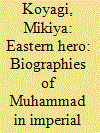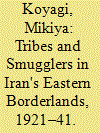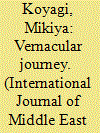|
|
|
Sort Order |
|
|
|
Items / Page
|
|
|
|
|
|
|
| Srl | Item |
| 1 |
ID:
193611


|
|
|
|
|
| Summary/Abstract |
While participating in the discourse of world religions, Japanese biographers published accounts of Muhammad’s life in many genres of academic and popular books during the Meiji and Taisho eras (1868–1926). This article unravels how these biographical accounts played a crucial role in facilitating a geographical imaginary of Asia/the East which incorporated both Japan and West Asia. Situated in a radically different context from the Victorian biographers who inspired them, Japanese biographers constantly compared Muhammad to historical figures familiar to them, most notably Buddha and Nichiren, and reinterpreted the life of Muhammad, relying exclusively on European-language sources. In particular, in contrast to another strand of pan-Asianism that stressed peacefulness as an inherent quality of the East, the biographers identified Muhammad’s perceived militancy and the miracles he performed as signs of the values shared by Japan and Islamic civilization. Using the person of Muhammad as a concrete piece of evidence, Japanese biographers reimagined an Eastern civilizational space that could stretch from Tokyo to Mecca.
|
|
|
|
|
|
|
|
|
|
|
|
|
|
|
|
| 2 |
ID:
184809


|
|
|
|
|
| Summary/Abstract |
Based primarily on British consular reports, this article studies transborder movement in Iran's eastern borderlands during the two decades following the rise of Reza Khan in 1921. It discusses two kinds of transborder movements: tribal exodus and smuggling. By examining the contexts of these transborder movements, this article explores the desire of the new state to assert sovereignty as it appeared in the borderlands and demonstrates that, rather than simply closing the borders, the Pahlavi state attempted to control the flows of people and goods, with dual effects. It introduced new constraints to mobility and as well fostered the development of borderland networks that enabled diffused transborder movement, making it harder for the authorities to control.
|
|
|
|
|
|
|
|
|
|
|
|
|
|
|
|
| 3 |
ID:
141813


|
|
|
|
|
| Summary/Abstract |
Exploring how railway technology was incorporated into the everyday lives of Iranians during the second quarter of the 20th century, this article focuses on spatial discourses and practices around the Iranian railway. The first part investigates Iranian journalists' construction of the railway traveler prototype as the propagator of modernity prior to the completion of the Trans-Iranian Railway in 1938. The second part shows how in the 1940s the railway space became a microcosm of the heterogeneous Iranian nation, and explores how middle-class travelers experienced the railway space. I argue that the railway space, rather than creating a homogeneous experience of railway journeys, was conducive to fragmented experiences among its diverse occupants, who were divided by religion, socioeconomic status, cultural orientation, and ethnicity. The visibility of heterogeneity in the railway space compelled modern middle-class travelers to consolidate their class identity and distinguish themselves from the rest of Iranian society. Wanting to achieve a homogeneously Europeanized Iran, they also felt compelled to travel the country more extensively to create a national community connected through direct interaction.
|
|
|
|
|
|
|
|
|
|
|
|
|
|
|
|
|
|
|
|
|